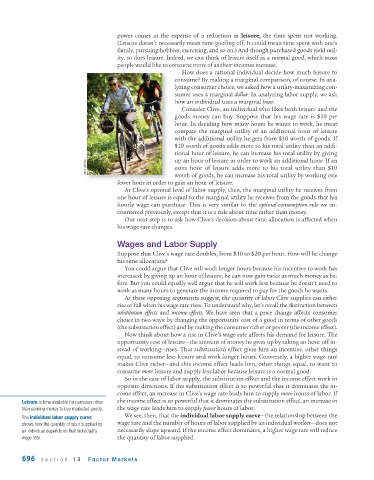Page 738 - Krugmans Economics for AP Text Book_Neat
P. 738
power comes at the expense of a reduction in leisure, the time spent not working.
(Leisure doesn’t necessarily mean time goofing off. It could mean time spent with one’s
family, pursuing hobbies, exercising, and so on.) And though purchased goods yield util-
ity, so does leisure. Indeed, we can think of leisure itself as a normal good, which most
people would like to consume more of as their incomes increase.
How does a rational individual decide how much leisure to
consume? By making a marginal comparison, of course. In ana-
lyzing consumer choice, we asked how a utility-maximizing con-
sumer uses a marginal dollar. In analyzing labor supply, we ask
how an individual uses a marginal hour.
Consider Clive, an individual who likes both leisure and the
goods money can buy. Suppose that his wage rate is $10 per
hour. In deciding how many hours he wants to work, he must
compare the marginal utility of an additional hour of leisure
with the additional utility he gets from $10 worth of goods. If
$10 worth of goods adds more to his total utility than an addi-
tional hour of leisure, he can increase his total utility by giving
istockphoto up an hour of leisure in order to work an additional hour. If an
extra hour of leisure adds more to his total utility than $10
worth of goods, he can increase his total utility by working one
fewer hour in order to gain an hour of leisure.
At Clive’s optimal level of labor supply, then, the marginal utility he receives from
one hour of leisure is equal to the marginal utility he receives from the goods that his
hourly wage can purchase. This is very similar to the optimal consumption rule we en-
countered previously, except that it is a rule about time rather than money.
Our next step is to ask how Clive’s decision about time allocation is affected when
his wage rate changes.
Wages and Labor Supply
Suppose that Clive’s wage rate doubles, from $10 to $20 per hour. How will he change
his time allocation?
You could argue that Clive will work longer hours because his incentive to work has
increased: by giving up an hour of leisure, he can now gain twice as much money as be-
fore. But you could equally well argue that he will work less because he doesn’t need to
work as many hours to generate the income required to pay for the goods he wants.
As these opposing arguments suggest, the quantity of labor Clive supplies can either
rise or fall when his wage rate rises. To understand why, let’s recall the distinction between
substitution effects and income effects. We have seen that a price change affects consumer
choice in two ways: by changing the opportunity cost of a good in terms of other goods
(the substitution effect) and by making the consumer richer or poorer (the income effect).
Now think about how a rise in Clive’s wage rate affects his demand for leisure. The
opportunity cost of leisure—the amount of money he gives up by taking an hour off in-
stead of working—rises. That substitution effect gives him an incentive, other things
equal, to consume less leisure and work longer hours. Conversely, a higher wage rate
makes Clive richer—and this income effect leads him, other things equal, to want to
consume more leisure and supply less labor because leisure is a normal good.
So in the case of labor supply, the substitution effect and the income effect work in
opposite directions. If the substitution effect is so powerful that it dominates the in-
come effect, an increase in Clive’s wage rate leads him to supply more hours of labor. If
Leisure is time available for purposes other the income effect is so powerful that it dominates the substitution effect, an increase in
than earning money to buy marketed goods. the wage rate leads him to supply fewer hours of labor.
We see, then, that the individual labor supply curve—the relationship between the
The individual labor supply curve
shows how the quantity of labor supplied by wage rate and the number of hours of labor supplied by an individual worker—does not
an individual depends on that individual’s necessarily slope upward. If the income effect dominates, a higher wage rate will reduce
wage rate. the quantity of labor supplied.
696 section 13 Factor Markets

